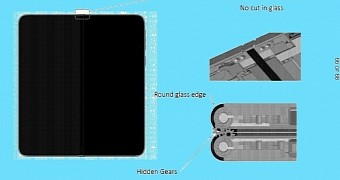Microsoft has never confirmed the Surface Phone, although it did drop several hints that such a project might be on its way, but in the last few months, we’ve seen several signs of a new mobile device that’s being developed by the Redmond-based software giant.
A supposed Surface Phone with folding displays showed up in several patents, and while such evidence is by no means a guarantee that a device can reach production, this kind of project just appears to make sense at this point. And we’re not the ones saying it, but Microsoft itself.
In a new patent (via MSPU), Microsoft explains that folding phones are necessary in order to offer users more screen space without compromising the phone form factor.
The company acknowledges that by reducing the screen bezels to a minimum, phone makers need to start looking elsewhere in order to increase display size, and unless customers agree to purchase gigantic devices just to have a bigger screen (which is very unlikely, of course), a folding design would be the best way to go.
“Along with these enhanced capabilities has come a demand for larger displays to provide a richer user experience. Mobile phone displays have increased in size to the point where they can now consume almost the entire viewing surface of a phone. To increase the size of displays any further would require an increase in the size of the phones themselves. This is not desirable, as users want their mobile phone to fit comfortably in their hand or in a shirt or pants pocket,” Microsoft explains.
Innovative hinge design and several form factors
Previous patent applications have shown that Microsoft developed a folding phone with an innovative hinge that would allow two separate displays to seamlessly become a single one when flat.
Furthermore, thanks to this hinge design, Microsoft’s device could offer more form factors, including a laptop-like design that would boost its productivity side.
“With a dual-display device, the mobile phone or tablet can include an open, expanded position where both displays are flush so that the user feels like there is a single integrated display. In a closed, condensed position, both displays are face-to-face so as to protect the displays. In a fully-open position, the dual displays can sit back-to-back so the user needs to flip the device to view the opposing display,” Microsoft further explains.
Despite all these signs that a Surface Phone could be coming, there’s no confirmation that Microsoft is ready to push it from patent to mass production, so don’t get your hopes too high for the moment.

 14 DAY TRIAL //
14 DAY TRIAL //